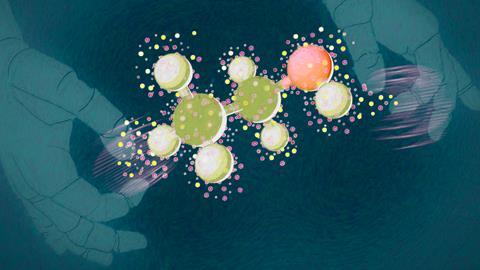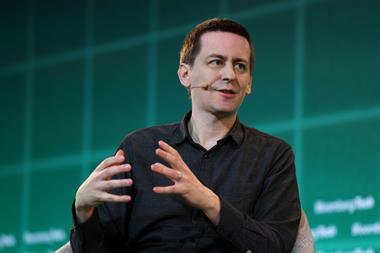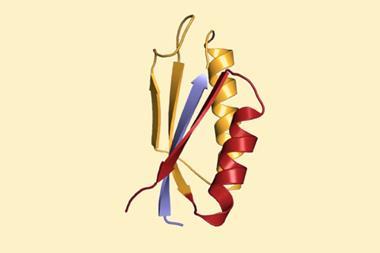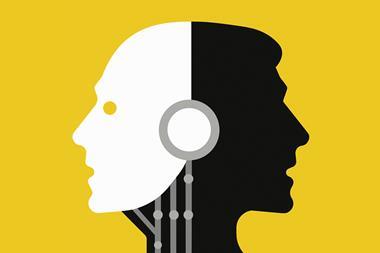With the awarding of the Nobel prize in physics to the development of neural networks and half of the chemistry Nobel for using artificial intelligence (AI) to predict protein structure last week, it’s clear that this technology is already making waves in science. AI is also reshaping the chemical industry in profound ways, with analysts predicting that its impact will surpass even that of the internet. From algorithms that accelerate molecular design to automated labs that enhance the speed and accuracy of experiments, AI is transforming how chemists solve complex problems. Its impact extends across materials discovery, reaction optimisation and sustainability efforts, making it an indispensable force in modern chemistry.
A recent analysis by Valentine Ananikov, a chemist and group leader at the Zelinsky Institute of Organic Chemistry in Russia, highlights his top 20 AI-based technologies transforming chemistry.
1 Drug discovery
Machine learning (ML) is already being used to sift through massive datasets from chemical, biological and medical sources. Advances like AlphaFold – rewarded with this year’s Nobel prize in chemistry – can predict how different chemical structures interact with biological targets, identifying potential drug candidates faster than traditional methods. BenevolentAI’s platform identified an existing compound as a potential new drug for amyotrophic lateral sclerosis in just a few months – a process that typically takes years.
2 Big data
Big data analytics aim to consolidate fragmented data from experiments, simulations and literature into an integrated system, but disparate data formats and small datasets make this challenging. Integrated chemical data can accelerate progress by enabling comprehensive data analysis and cross-disciplinary research.
3 Automated laboratory platforms
By harnessing robotics, software and AI to conduct experiments, it becomes possible to minimise human error whilst enhancing precision and reproducibility. AI-driven systems can perform complex synthetic tasks, as well as high-throughput screening, making them invaluable in drug discovery and materials science. AI plays a crucial role by enabling these platforms to analyse data in real time, optimise experimental conditions and make data-driven decisions. By handling hazardous materials and streamlining resource use, automated labs can also improve safety.
4 Integrating lab instruments and internet of things
Connecting devices to networks can enable automated data collection, real-time monitoring and seamless data analysis. Internet of things integration can facilitate various applications, from continuous drug synthesis monitoring in pharmaceuticals to real-time pollutant tracking in environmental science. The vast data collected allows for deeper insights, potentially leading to new discoveries, while ensuring enhanced safety through instant alerts for hazardous conditions.
5 AI in spectroscopy and analytical method development
ML algorithms are trained on large datasets of spectroscopic measurements and their corresponding interpretations. These algorithms then learn to recognise the complex relationships between spectroscopic features and chemical properties they represent, thereby reducing the time required for data analysis. AI-enhanced spectroscopy can rapidly identify contaminants in drug formulations ensuring drug quality, while in environmental monitoring it can detect trace pollutants in complex mixtures. AI also accelerates material characterisation and aids in fields like forensic science and food safety by improving sensitivity and reliability of data.
6 Blockchain for supply chain optimisation
Chemical industry supply chains face significant challenges, including inefficient inventory management and fragmented distribution networks. Using a distributed ledger technology, each transaction in the supply chain can be recorded as a block of data, which is then linked to the previous transaction, forming a secure, trackable blockchain. This can tackle counterfeiting and ensure regulatory compliance by providing a permanent record of product authenticity, safety data and environmental impact. Blockchain enhances recall processes, dispute resolution and inventory management, while smart contracts automate operations, reducing costs.
7 Digital twins
Virtual models can be used to accurately mirror real-world chemical reactions, processes or systems in real-time. By integrating data from sensors and performance records, these digital replicas simulate the physical and chemical behaviour of their counterparts. With digital twins, chemical processes can be optimised by simulating parameter changes without the risks or costs of physical experiments. They also predict equipment failures, enhance safety strategies and facilitate stress testing where real-world scenarios would be too costly or dangerous.
8 Augmented reality and virtual labs
Virtual labs include simulations and digital tools that replicate real experiments, letting students change variables and observe outcomes in real-time. This modern approach to teaching and learning can reduce costs, improve safety and allow for repeated trials, making learning more flexible and accessible. It also promotes inclusivity and accessibility, ensuring that students from diverse backgrounds and geographical locations have equal opportunities.
9 Natural language processing in the chemical space
By applying AI to analyse and extract insightful data from vast amounts of scientific literature, patents and chemical databases, natural language processing converts unstructured text into structured data for more efficient interpretation. This can uncover hidden connections and patterns in scientific literature that may not be apparent through conventional reading, allowing researchers to focus on experiments. In pharma, natural language processing aids in drug discovery and development by extracting information on bioactive compounds, targets and therapeutic effects.
10 Predictive toxicology
Computational models can be harnessed to anticipate the toxicity of chemical compounds, thereby preventing adverse health and environmental effects before they occur. This approach enhances chemical safety assessments in drug development and agrochemicals, reducing the risk of costly late-stage failures. Advanced techniques, such as ML and multiscale-weighted coloured graphs, improve the accuracy of toxicity predictions, enabling safer chemical design and potentially minimising reliance on animal testing.
11 AI in green chemistry
Digital platforms facilitate the precise modelling of pollutant dispersion and the identification of contamination sources. By integrating computational models, data analytics and remote sensing technologies, AI can enable real-time monitoring of air and water quality, soil composition and hazardous substance accumulation. This can improve environmental monitoring and pollution control. Digital tools can also support the discovery of environmentally friendly materials, energy-efficient processes and waste-minimisation techniques.
12 Molecular design
AI algorithms can leverage vast amounts of chemical data, including molecular structures, their associated properties and experimental outcomes to identify relationships between molecular structures and predict their behaviours. ML can expedite the discovery of pharmaceuticals with improved efficacy and fewer side effects, guide the development of efficient energy materials for solar cells and batteries, and contribute to sustainable practices by creating recyclable materials.
13 Smart control
Intelligent control systems use advanced algorithms, sensors and automation technologies to improve efficiency and safety in chemical operations. By monitoring real-time process parameters and making data-driven adjustments, these systems optimise complex chemical reactions, thereby reducing waste and energy consumption, without the need for constant human oversight. These systems also bolster safety by detecting hazards and enabling predictive maintenance to prevent costly downtime.
14 Predicting structure–activity relationships using deep learning
By training neural networks on extensive datasets, these systems can recognise complex patterns in molecular structures that correlate with biological outcomes, moving beyond traditional analysis methods. Deep learning can predict the efficacy of potential drugs, anticipate adverse reactions and suggest structural modifications to optimise lead compounds to aid drug discovery. These models can also provide insights into biological pathways, offering a deeper understanding of disease processes and pharmacology, thereby allowing the identification of new therapeutic targets.
15 AI-driven high-throughput experimentation
High-throughput experimentation combines robotics, automation and AI to conduct multiple chemical experiments simultaneously and swiftly. High-throughput systems can also analyse hundreds to thousands of samples daily, minimising human error and allowing researchers to focus on more complex aspects of their work. By accelerating experiments and analyses, High-throughput experimentation shortens R&D cycles for new chemicals, materials and drugs. This also generates extensive datasets that can enrich computational analysis and improve AI’s predictive capabilities.
16 Digital materials design and materials informatics
By analysing large datasets of material properties, processing conditions and performance metrics, AI can predict material performance based on structure and composition. This approach accelerates the identification of high-performance materials for critical applications in aerospace, energy and electronics, leading to lighter, stronger and more sustainable solutions.
17 AI for chemical reaction optimisation
By collecting and analysing data on chemical reactions, such as reactants, catalysts, solvents, temperatures and yields, AI can predict reaction outcomes and refine chemical conditions. This allows chemists to simulate reactions virtually, saving time and resources by targeting the most promising conditions before testing them in the lab. The approach is applicable across synthetic chemistry, materials science and drug discovery, enhancing yields and selectivities in complex organic synthesis and streamlining the production of active pharmaceutical ingredients.
18 Automated synthesis planning
Using ML algorithms, automated synthesis planning systems analyse vast chemical reaction databases – both successes and failures – to propose and rank multiple synthetic routes. By considering factors like steps required, material availability and cost, these systems uncover the most promising and practical strategies, particularly valuable in drug development where time is critical.
19 Chemoinformatics
Chemoinformatics combines ML techniques to manage large chemical datasets, transforming raw data into actionable insights. AI can be used to identify patterns across chemical structures, properties and biological activities, streamlining virtual screening in drug discovery and materials science. Predictive AI models can forecast chemical properties with high accuracy, contributing to the development of new technologies and solutions across a broad range of scientific disciplines.
20 AI in quantum chemistry
Quantum chemical calculations can be notoriously difficult and computationally demanding. By training AI models on quantum chemistry and molecular simulations, researchers can reduce computational costs and time whilst offering a deeper understanding of fundamental molecular phenomena, including reaction mechanisms and material behaviours that were previously inaccessible.
References
VP Ananikov, Artif. Intell. Chem., 2024, 2, 100075 (DOI: 10.1016/j.aichem.2024.100075)


















No comments yet